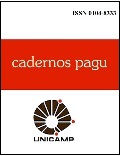Abstract
This article explores the readings and assessments of media content about gender violence made by women who are victims / survivors of violence. Using a discussion group technique, a group of women with experiences of violence reflected on the quality of information, the importance of professionals and their own responses to current media treatments of this social problem. Among the results, it is worth highlighting criticisms of the superficiality and sensationalism still present in the social communication media.
References
ALAT, Zeynep. News coverage of violence against women. The Turkish case. Feminist Media Studies, 6(3), 2006, pp.295-314.
ANDERSON, D. K. y SAUNDERS, D. G. Leaving an Abusive Partner: An Empirical Review of Predictors, the Process of Leaving, and Psychological Well-Being. Trauma, Violence, & Abuse, (4), 2003, pp.163-191.
BADURA, Albert. Teoría social cognitiva de la comunicación de masas. In: BRYANT, Jennings y ZILLMANN, Dolf (comp.). Los efectos de los medios de comunicación. Investigaciones y teorías. Barcelona, Paidós, 1996, pp.88-126.
BARON, Robert; BYRNE, Don. Social psychology. Understanding human interaction. Boston, Allyn and Bacon, 1994.
BERKOWITZ, Leonard. Some effects and thoughts on anti-and prosocial influences on media events: a cognitive-neoassociation analysis. Psychological Bulletin, 95 (3), 1984, pp.410-427.
COYLE, Imelda. Sampling in qualitative research: purposeful and theoretical sampling; merging or clear boundaries? Journal of Advanced Nursing (26), 1997, pp.623-630.
DE MIGUEL, Ana. La construcción de un marco feminista de interpretación: la violencia de género. Cuadernos de Trabajo Social, 18, 2005, pp.231-248.
FESHBACH, Seymour. The catharsis hypothesis, aggressive drive and the reduction of aggression. Aggressive behavior (10), 1984, pp.91-101.
FULU, Emma et alli. Why Do Some Men Use Violence Against Women And How Can We Prevent It. Bangkok, Tailandia, UNDP, UNFPA, UN Women, UN Volunteers, 2013.
GANITO, Carla y FERREIRA, Cátia. Women and digital Reading: the gendering of digital Reading practices. In: CERQUEIRA, Carla; CABECINHAS, Rosa; MAGALHAES, Isabel (ed.). Gender in focus: (News) trends in Media. Braga, CECS-Centro de Estudos de Comunicação e Sociedade Universidade do Minho, 2016, pp.205-232.
GLASER, Barney. Grounded Theory 1984-1994. Mill Valley, ca, Sociology Press, 1995.
GLASER, Barney. Basics of Grounded Theory Analysis: Emerge vs Forcing, Mill Valley, 1992.
GLASER, Barney. Doing Grounded Theory. Mill Valley, Ca, Sociology Press, 1978.
HARRIS, Richard. A cognitive psychology of mass communication. Mahnaw, N.J., Lauwrence Erlbaum Associates, 1999.
HEILMAN, Brian; HEBERT, Luciana; PAUL-GERA, Natasia. The Making of Sexual Violence: How Does a Boy Grow Up to Commit Rape? Evidence from Five IMAGES Countries. Washington, EEUU, International Center for Research on Women (ICRW), Instituto Promundo, 2014.
MARTÍN-BARBERO, Jesús. Matrices culturales de la telenovela. Estudios sobre las culturas contemporáneas 2(005), 1998, pp.45-69.
MARTÍN-BARBERO, Jesús. Televisión y melodrama. Géneros y lecturas de la televisión en Colombia, 1992. http://infohumanidades.com/sites/default/files/apuntes/25%20-%20martin%20barbero%20Television%20y%20melodrama.pdf . Acceso el: 28/10/2021.
MARTÍN-BARBERO, Jesús. La telenovela en Colombia: televisión, melodrama y vida cotidiana. Signo y pensamiento (11), 1987, sp.
MILLER, David. Review of Women viewing violence. Critical Social Policy (40), 1994, pp.97-101.
PHILLIPS, David. The found experiment: a new technique for assessing the impact of mass media violence on real-world aggressive behavior. In: COMSTOCK, George (ed.). Public Communication and Behavior, v. I, Orlando, F.L., Academic Press, 1986, pp.260-308.
PUJADAS, Juan. José. El método biográfico. El uso de las historias de vida en ciencias sociales. Madrid, Centro de Investigaciones Sociológicas, 1992.
RADWAY, Janice A. Reading the Romance: Women, Patriarchy, and Popular Literature. Chapel Hill, NC, The University of North Caroline Press, 1991.
SANMARTÍN, José et alii. III Informe Internacional. Violencia contra la mujer en las relaciones de pareja (estadísticas y legislación). Serie Documentos v.16, Valencia, España, Centro Reina Sofía, 2010.
SCHLESINGER, Philip et alii. Kay Women Viewing Violence. Londres, RU, BFI, 1992.
SORIANO, Jaume. Las mujeres ante la información de violencia de género. Sphera Pública (4), 2004, pp.51-170.
SUTHERLAND, Georgina et alii. Media guidelines for the responsible reporting of violence against women: a review of evidence and issues. Australian Journalism Review, 38(1), 2015.
SPARKS, Glen; SPARKS, Cherry W. Violence, mayhem and horror. In: ZILLEMAN, Dolf y VORDERER, Peter (ed.). Media entertainment. The psychology of its appeal. Mahwah, NJ, Lawrence Earlbaum Associates, 2000, 73-91.
STRAUSS, Ansel. Mirrors and Masks. Nueva York, NY, Free Press, 1959.
STRAUSS, Ansel; CORBIN, Juliet. Basics of Qualitative Research: Grounded Theory, Procedures and Techniques, London Sage, 1990.
VIVES-CASES, Carmen; TORRUBIANO, J.; ÁLVAREZ-DARDET, Carlos. The effect of television news items on intimate partner violence murders. European Journal of Public Health, 19(6), 2009, pp.592-596.

This work is licensed under a Creative Commons Attribution 4.0 International License.
Copyright (c) 2021 Belén Zurbano-Berenguer, Salomé Solá-Morales, Sergio Marín-Conejo


